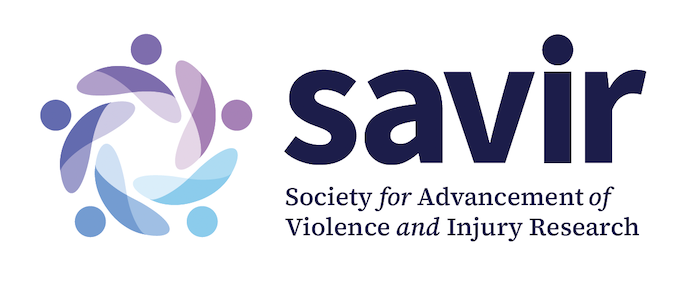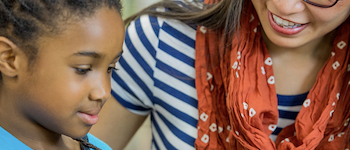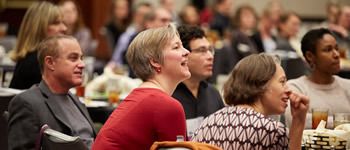Complete Story
04/01/2024
Interview with Laura Schwab Reese
Tell us a little about yourself, your research and areas of interest.
Where do you work and what is your current title?
I’m an Associate Professor of Public Health at Purdue University in West Lafayette, Indiana. I came to Purdue from a postdoc at the Kempe Center at the University of Colorado Anschutz. Before that, I completed a PhD in community and behavioral health at the University of Iowa.
How long have you been in the field of Injury and Violence Research?
Mentoring guides people to the field of injury and violence prevention, and my story is no different. I started working on injury and violence research as a PhD student in 2011 with my advisor, Dr. Ginger Yang. Ginger and I worked on primarily sports injury research, although we also completed a small project on child maltreatment. When Ginger left Iowa at the end of my first year, I switched to working with Drs. Corinne Peek-Asa and Marizen Ramirez. I was fortunate to be exposed to various injury and violence outcomes and research approaches as a PhD student. My dissertation focused on predicting intimate partner violence, which sparked my interest in understanding early life contributions to violence. I learned about a child maltreatment-focused postdoc at the 2015 SAVIR conference in New Orleans from Dr. Carol Ruyan. At the Kempe Center, I worked on several child maltreatment-related projects, including an international comparison of child protective services systems, and understanding how technology can be used to understand child maltreatment.
Since coming to Purdue, I’ve focused primarily on child maltreatment-related research with an emphasis on how technology can be used to support people experiencing violence. To accomplish this work, I run the VISTA (Violence, Intervention, Support, Technology, + Action) team. I’ve been PI/co-PI of $7 million in grants with an additional $4 million as a key investigator. With VISTA, I’ve trained and supported dozens of students. Most of the students who work with me don’t know about injury/violence prevention. It's really rewarding to see many of them go on to work in injury/violence-related roles.
I’m committed to community-academic partnerships. Indiana has a lot of injury/violence-related needs, so I also do a lot of work on local intervention development or evaluation projects. Much of my work impacts lives directly, and it’s been gratifying to be recognized for these efforts. I received the Kempe Award from the International Society for the Prevention of Childhood Abuse and Neglect, the ICEHS Early Career Award, and the Promoting Pediatric Primary Prevention Award from HRSA.
How long have you been a member of SAVIR?
I joined SAVIR before the 2013 SAVIR-Safe States conference, so it’s been a bit over ten years. I learned about SAVIR from Ginger before I started the program. We were setting up a meeting to discuss my fit with her team but had to postpone a week because the Iowa IPRC was hosting the SAVIR conference. So, I heard good things about SAVIR even before I decided to switch from a focus on mental health to injury/violence!
Why did you join SAVIR?
I wanted to attend the conference, and it was less expensive to do so as a member. I would guess that many of our student/early career members come to us that way! But, I decided to stay engaged because I really liked building connections with other people in the field, and SAVIR provides an opportunity to interact across disciplines and methods and really develop leadership within the field.
What Committees have you served on?
I was quite active on the Training and Infrastructure Committee for several years, including a year as the liaison to the Board. I was part of TIC while SAVIR was with a previous management company and saw how difficult it was to make progress without sufficient management/professional support. I kept these challenges at the front of my mind as we made decisions during my term as president. I also briefly participated in the Advocacy & Policy Committee. I regret not being more engaged with that group because they do such awesome work!
What are some of the things you enjoy most about SAVIR?
I love connecting with ‘my’ people. I regularly say that injury and violence researchers/practitioners are some of the best, most collaborative people in academia. Lots of academics are ultra-competitive and focused on the ‘glory’ more than the impact of their work on the health and well-being of people. I love that SAVIR members tend to focus more on collaborating to create meaningful change.
What interested you in the SAVIR President role?
Truthfully, I was a bit of a hard sell. I’ve chaired other injury/violence-focused organizations, so I knew that it was A LOT of work, and I was going up for tenure at the time I was asked! But, I also recognized this was a critical time for SAVIR. If SAVIR was going to recover from the pandemic-related challenges, it needed someone with business management experience to oversee the transition to a new organizational structure. Since I worked in human resources before getting my PhD and had experience leading other professional organizations, it felt like I was the right person for the job. And I wasn’t wrong, I’ve guided the organization through hiring decisions, contract negotiations, management reorganization, conference planning, and so much more. Thankfully, I didn’t have to fire anyone. That was always my least favorite part of HR!
What did your responsibilities include as President of SAVIR?
I don’t think we have enough space to cover all my responsibilities! During my incoming President’s speech in Denver, I promised to promote SAVIR as a place for connection and reprieve from the challenges that arise from our professional work and world events. I worked hard to build up the capacity of the organization to support our members and give them the space to connect. When I reflect on my Presidency, I see my work in two major buckets: management and injury/violence leadership.
Most of my work focused on the behind-the-scenes functioning of the organization, which isn’t the most visible or fun work but was critical to keep us moving forward. The pandemic was a challenging time for SAVIR, so my primary goal as President was to move SAVIR in a more sustainable direction. We’ve had some issues related to misalignment between our goals and the prior management companies and that challenged our ability to make meaningful progress. It also could cause burnout for our amazing members who dedicate so much of their time. Moving to a new management direction was important for long-term sustainability. During my term, we brought on an Executive Director and a part-time staff person (Christen Rexing and Sara Brandspigel)! We’ve already seen that having injury/violence-focused management helps align our activities and efforts with our goals.
With a new SAVIR structure, we needed a new brand. I initiated and oversaw the process of re-branding and launching a new website! Our current website didn’t serve our needs, and I’m excited to have a fresh, new website this summer. Beyond looking cool (and featuring our fancy new logo and branding!), the new website platform has a ton of capabilities that will make it easier for SAVIR members to find information, connect with others, and hear from SAVIR. I am excited that it will be a part of my legacy!
We also strengthened our relationships with partner organizations and found new revenue sources, which allowed us to expand what we can offer members. We hosted our first annual Fall Symposium and Methods Spotlight, our programming and member benefits quadrupled, and we are coming into our strongest post-COVID conference yet.
As the dust starts to settle after the transition, I’m hopeful SAVIR leadership will have more opportunities for fun things, like figuring out how to raise money for student/early career opportunities, supporting connections and collaborations across our members, and highlighting the terrific work of SAVIR members.
What did you enjoy more about being in the President role?
The best part of my Presidency was connecting with SAVIR members, because we’re such a great group! I also enjoyed working with our staff, Executive Committee, and the Board. It’s been really exciting to see the new management structure coming together. It’s exciting to see how these changes are already benefiting the members, and I can’t wait to see all the ways SAVIR will be able to grow in the future.
What are you hoping to see in the future of SAVIR?
Injury/violence prevention can be misunderstood or underappreciated. Especially when there are only a couple of people at an institution focused on these topics, it’s easy to feel pretty isolated. I’m looking forward to seeing how the new management structure and professional staff lead to creative new opportunities for members to connect and collaborate. I’m also excited to see how our new brand and much more modern website increases our external presence and elevates our work.
Beyond that, SAVIR is starting a President’s Series, which will run every summer. My seminar will focus on lab and project management. I can’t wait to see what other presidents will do in their seminars. I’m also starting a SAVIR writing group this fall. I participate in a non-IVP focused group and it’s great. It allows me to carve out time to write and connect with others, so I thought that would be awesome to do with SAVIR members.
What accomplishment are you most proud of? Personally and/or professionally.
I recently received tenure at a research-intensive university. That is a huge accomplishment in itself, but I’m especially proud because I grew up in a super rural, low-income area in Iowa and was a first-generation college student. I didn’t grow up with people who modeled academic/professional success. I’m super proud of overcoming these challenges, and I’m also proud of how I’m using my successes to try to open doors for others.
Is there anything else you would like SAVIR members to know about you, the role of SAVIR President or the future of SAVIR?
SAVIR members are doing such amazing work. I’m so grateful to have the opportunity to lead the organization.




